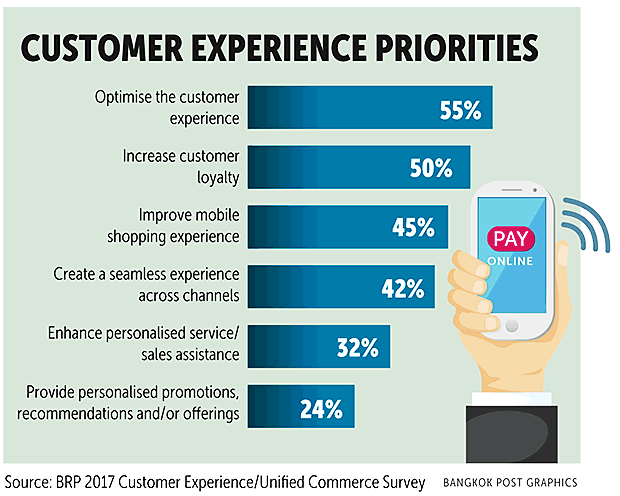Thailand: Retail shows power of personalisation
Most retailers are looking for ways to improve the consumer experience with their brand, but few are equipped to apply one of the most obvious and powerful approaches available, which is personalisation, says Diebold Nixdorf, a multinational provider of connected commerce and cash-handling products and services.
In a survey to gauge retailers’ customer experience priorities last year, the US-based retail and restaurant specialists BRP Consulting found 55% of respondents said that optimising the customer experience was their top priority. Increasing customer loyalty was a close second (50%) and improving the mobile shopping experience (45%) came third.
However, only 24% of respondents indicated that providing personalised promotions, recommendations and/or offerings was a top priority.
“Strange as it may sound, this discrepancy is understandable if you think about it,” wrote Reint Jan Holterman, global product marketing manager for retail software with Diebold Nixdorf, in a recent blog post.
“Before you can start working on providing personalised promotions, you need to have the foundation in place.
“An optimised, seamless customer experience across all sales channels, a well thought-through loyalty programme and the ability to get in touch with customers via their most cherished and most personal device — their smartphone — all need to come first.”

Personalisation, Mr Holterman believes, will gain importance quickly, as more and more retailers make progress on laying the foundations for their customer experience and loyalty programmes.
“Personalisation is an absolute must-have for retailers, as it helps set them apart from the competition. Consumers, especially the millennials among them, no longer accept a ‘one-size-fits-all’ approach. It needs to be tailor-made, personalised to the max.”
Personalisation is also key for running successful loyalty campaigns in retail. It is an essential ingredient for enhancing the customer experience, because nothing feels (or sells) better than bringing implicit needs and wants to the table — and the best retailers will know exactly which ones the customer was just thinking about.
Personalisation is about being “in the moment” with each individual customer, and anticipating his or her needs as they are evolving.
“One could say that in the end, the consumer is the only remaining channel that retailers need to care about,” said Mr Holterman.
Technology enables personalisation: Being able to personalise an experience requires in-depth understanding of an individual consumer. His whereabouts, preferences, desires and needs, his household and his financial situation, and his purchasing behaviour, for example. This calls for smart data collection and smart data analysis.
According to a study by Zebra Technologies, 70% of retailers are planning to invest in Internet of Things (IoT) technologies by 2021.
They expect that in-store technologies such as sensors for tracking foot traffic, beacons for location-based marketing, electronic shelf labelling (ESL) and smart sensors for inventory management will be “giving a digital voice to people, processes and things to improve the consumer experience, enhance supply chain visibility and expand revenue opportunities”.
Part of the digital store transformation process, this “digital voice” of the consumer can be stored, analysed and used to further improve in-store experiences.
Tapping into smart data at home: At home, technological advancements also support the collection of smart data. “Just think about the new ‘domotica’ or home automation applications that are rapidly gaining ground,” said Mr Holterman.
“For example, the smart kitchen tool Hiku lets consumers simply build their shopping lists at home.
“Amazon Dash enables you to instantly order laundry detergent or many other items you’re running out of. Smart refrigerators signal when you need more milk.
“Alexa, together with Amazon Echo, allows you to order just about any item online without even touching your smartphone or notebook.”
Such devices are not only extremely convenient for users, they also provide a wealth of personal information that retailers can leverage to personalise their engagement with individual consumers and with households.
How to get personal?
Mr Holterman offers some advice from Jeffrey Neville, a BRP vice-president who once said: “Personalisation may be the most powerful way for retailers to differentiate their brand and enhance the customer experience. The challenge is to identify the best method to customise the experience for each customer.”



 English
English




